You are using an out of date browser. It may not display this or other websites correctly.
You should upgrade or use an alternative browser.
You should upgrade or use an alternative browser.
Around the world on a solar ebike
- Thread starter solarEbike
- Start date
solarEbike
100 W
E=IR said:What do you consider the maximum width for solar panels on a trailer? Perhaps the same width as the handlebars?
Assuming a solar panel made from 125 mm wide Sunpower cells, 6 cells wide seems to be the most common width among The Sun Trip participants although I've noticed one or two vehicles which used panels that were 7 cells wide. The Sun Trip Technical Regulations (PDF) impose a 99 cm (39") max width limit when the vehicle is moving. This allows additional slide-out/fold-out panels for stationary charging.
In my own test riding, I've found 6 cells wide to be a reasonable maximum width. This works out to be 80 cm (31.5") maximum trailer width when my panel is at a 0° tilt angle (horizontal) which is a little wider than my handlebars which are 76 cm (30") including left and right mirrors.
Since my trailer has a motorized tilt mechanism, I can easily tilt the panel at the touch of a switch to reduce my trailer's width when I need to fit trough a tight gap such as barriers at bike paths or passing cars stopped at traffic lights. It's wonderful to be able to do this on the fly but I certainly wouldn't consider it a requirement.
Also, consider the width of any doors you may want your trailer to fit through.
I worked for Boeing many years and I've drilled millions of holes in the stuff.
Just a quick one, carbon can be drilled more successfully with "dagger" drills and solid carbide at high speed will not suffer as much fibre breakout etc.
std operation for say a 3/16" hole would be a 1/8th dagger drill pilot hole and a 3 step solid carbide reamer to open up the hole, high speed is fine.
RE Carbon fibre dust - under the microscope carbon is not at all like asbestos and does not have a hook which asbestos does hence the human body deals with carbon fibre dust just fine.
RE electrical conductivity is very very low, the resin is nil and the dissimilar materials you mention is due to the hydroscopic nature of carbon and it does hold moisture, separation of aluminium and carbon in the aircraft industry is achieved with paint on the aluminium surfaces and polysulfide sealants which keep the moisture out of the joints which would otherwise gather moisture whilst the aircraft temperature changes rapidly during climb / descent. Terrestial much less of an issue and paint of surfaces in contact with each other should be sufficient.
My X wife occ hygenist (dust noise chemicals etc in industrial environments) did a project where rats were subjected to airborne cured carbon dusts and they only die when the amount becomes too much for their lungs to clear it. For humans thats a shit load of dust and you can work in a trimming booth for a day cut up hundreds of parts and have no ill effects other than black dust in your nose.
Hacksaw whilst it works, doesnt work for long and i suggest an angle grinder with cutoff wheel or better yet a diamond wheel that you would use for cutting ceramic tiles works a treat.
Happy cutting!
Awesome project - next level stuff - well done!
Just a quick one, carbon can be drilled more successfully with "dagger" drills and solid carbide at high speed will not suffer as much fibre breakout etc.
std operation for say a 3/16" hole would be a 1/8th dagger drill pilot hole and a 3 step solid carbide reamer to open up the hole, high speed is fine.
RE Carbon fibre dust - under the microscope carbon is not at all like asbestos and does not have a hook which asbestos does hence the human body deals with carbon fibre dust just fine.
RE electrical conductivity is very very low, the resin is nil and the dissimilar materials you mention is due to the hydroscopic nature of carbon and it does hold moisture, separation of aluminium and carbon in the aircraft industry is achieved with paint on the aluminium surfaces and polysulfide sealants which keep the moisture out of the joints which would otherwise gather moisture whilst the aircraft temperature changes rapidly during climb / descent. Terrestial much less of an issue and paint of surfaces in contact with each other should be sufficient.
My X wife occ hygenist (dust noise chemicals etc in industrial environments) did a project where rats were subjected to airborne cured carbon dusts and they only die when the amount becomes too much for their lungs to clear it. For humans thats a shit load of dust and you can work in a trimming booth for a day cut up hundreds of parts and have no ill effects other than black dust in your nose.
Hacksaw whilst it works, doesnt work for long and i suggest an angle grinder with cutoff wheel or better yet a diamond wheel that you would use for cutting ceramic tiles works a treat.
Happy cutting!
Awesome project - next level stuff - well done!
solarEbike
100 W
KarlJ said:I worked for Boeing many years and I've drilled millions of holes in the stuff.
Hey Karl. Thanks so much for sharing your industry experience and knowledge about working with carbon fiber. I've cobbled together what I know mostly from working on a handful of fiberglass projects and doing an insane amount of internet research. The how-tos out there range from cringe-inducing YouTube videos of teenagers handling raw fiber and epoxy without gloves to academic papers and industry literature which can be difficult to adapt to a small workshop. Your practical advice is appreciated.
KarlJ said:RE Carbon fibre dust - under the microscope carbon is not at all like asbestos and does not have a hook which asbestos does hence the human body deals with carbon fibre dust just fine.
I think you're referring to when I wrote "Your body doesn't know what do with this stuff when it's embedded in your skin or your lungs." In hindsight, I'm not sure where I got that. I may have read that about carbon nanotubes and conflated it with some of the more alarmist precautions about working with carbon fiber in general. Definitely no nanotubes here. I assume you mean that wearing a good dust mask is a must but don't panic if you blow your nose later and see a few black particles.
KarlJ said:RE electrical conductivity is very very low, the resin is nil and the dissimilar materials you mention is due to the hydroscopic nature of carbon and it does hold moisture, separation of aluminium and carbon in the aircraft industry is achieved with paint on the aluminium surfaces and polysulfide sealants which keep the moisture out of the joints which would otherwise gather moisture whilst the aircraft temperature changes rapidly during climb / descent. Terrestial much less of an issue and paint of surfaces in contact with each other should be sufficient.
Good to know. A coat of paint is much simpler than always planning to have a layer of glass between fiber and aluminum. I assume my bike is going to be subjected to a lot of rain and occasional airborne salt when touring along coasts. The combination of water and salt tends to accelerate corrosion so I err on the side of caution when possible.
My concern about electrical conductivity is also based on a first hand account of a solar panel on a solar race car catching on fire. This was believed to have been caused by an electrical short through a carbon fiber body panel. I think the lesson is to remember that extra caution is required when routing wires through carbon body panels as opposed to fiberglass ones.
Cephalotus
10 kW
- Joined
- Jun 18, 2012
- Messages
- 755
solarEbike said:Mostly, I’m breaking radio silence to share an interesting development that’s come to my attention recently. LightLeaf Solar is a new Canadian startup offering custom-made solar panels uniquely suited for use on an ebike: good weight/power ratio and integrated with a stiff structural panel so they’re self-supporting.
They do look nice. Thank you for the link.
Do you already have an indiction about the price they do ask per Wp and how much customization is available?
solarEbike
100 W
Cephalotus said:Do you already have an indiction about the price they do ask per Wp and how much customization is available?
I do not have any specifics beyond what is on their web site and Instagram account. Based on the materials and the fact that these are being hand-assembled in small quantities in Canada, I would expect a price range of US$10-20 per watt. At least one page on their site seems to indicate they're willing to discuss any customization. Two other custom panel builders I've spoken with both had maximum panel sizes based on the dimensions of their laminating equipment but were willing to accommodate any custom shapes and designs within their fabrication abilities.
Cephalotus
10 kW
- Joined
- Jun 18, 2012
- Messages
- 755
Do you happen to know about builders of custom made lightweight solar panels within the EU?
because of VAT, customs and transport and warranty reasons this is obviously the preferred choice for me living there.
I know about Solbian but afaik the do not make lightweight rigid panels. I'm still into that aluflex stuff that adds a bit more than 2kg per m².
My latest design idea is to us my six 50W panels at roughly 55cmx56cm (depends on how much I cut of from the sides) in a /\ configuration with 3 panels on each side, that can also change into a total / or \ or _ _ configuration. Prefered with motors, but Im not sure if I'm able to design a good auto tracking system, but maybe the benefit in that case would be rather small anyway.
At 30° angle the width would be smaller than 99cm and at a 60° angle the width of the array would be smaller than 60cm. This /\ setting could also be helpful when experiencing stronger side winds. For transport in trains etc. it would be nice if I could fold them down to the size of a single panel.
Obviously at least two MPP trackers are needed for each side. Reaction time when the sun is switching from left to right in a /\ setting is much quicker, because its pure electronic (MPP trackers finding the new MPP) vs mechanical, but the disadvantage is high weight. My solar panels plus aluflex do weight around 1,8kg for 50W or 11kg for 300W and this is without the tilting mechanism and the central main support pole.
The panels that you linked could probably be made at almost half that weight which would be a significant benefit.
Those 300W generator in a 30° angle at a /\ configuration throws only the shadow of a flat 165cm to 99cm solar panel (as long as the sun shines on both sides) and so will only produce as much energy as such a 165cm x 99cm panel vs the real panel size of 165cm x 112cm while riding (at sun trip rules with 99cm maximum width) from the direct radiation impact.
For the diffuse amount of radiation I don't know bit expect it to be closer to its real panel size.
Of course the power generation will be better at / , \ and _ _ configuration if the angle matches the direction of the sun, so this would be the preferred configuration during rest times.
Why I do want to to that?
1. Because I already do have those panels and otherwise it is not possible to stay below 1m width. I also want to keep the length of my solar generator below 2m.
2. Compared to a fixed flat setup at 165cm x 112cm the loss from direct radiation would be 99cm/112cm = ca. -12%. Because of the amount of diffuse radiation I guess the loss is lower than 10%.
When the sun is lower than 60° above the horizon from one side the shadow of that / \ array will be larger than the shadow of the flat _ _array, so the production will be better.
3. If the rider casts a shadow on the solar generator often the shadow will only hit one half of the generator, so only one half would be affected (the half that faces away from the sun anyway). This is only a benefit vs a solar generator with a single row of modules in series, not vs a 2x "3p" configuration.
I plan to use those three 50W moduls on each side in parallel connected by shottky diodes. I hope that the shadow by the rider will only affect one module. My modules are made from half cells so they have around 2,8A I MPP and around 17V U MPP, in parallel under ideal conditions that would be 18V (minus 0,2V for the diodes) and 8,4A which fits the Genasun Boost chargers.
It would be better to have one charger for each module, but sadly I can't shit money.
4. The generator can get smaller than 60cm in width when the panels are at 60° angle which should be helpful in some situations.
5. the / \ configuration could be less sensible to side winds than a / or \ configuration ???
because of VAT, customs and transport and warranty reasons this is obviously the preferred choice for me living there.
I know about Solbian but afaik the do not make lightweight rigid panels. I'm still into that aluflex stuff that adds a bit more than 2kg per m².
My latest design idea is to us my six 50W panels at roughly 55cmx56cm (depends on how much I cut of from the sides) in a /\ configuration with 3 panels on each side, that can also change into a total / or \ or _ _ configuration. Prefered with motors, but Im not sure if I'm able to design a good auto tracking system, but maybe the benefit in that case would be rather small anyway.
At 30° angle the width would be smaller than 99cm and at a 60° angle the width of the array would be smaller than 60cm. This /\ setting could also be helpful when experiencing stronger side winds. For transport in trains etc. it would be nice if I could fold them down to the size of a single panel.
Obviously at least two MPP trackers are needed for each side. Reaction time when the sun is switching from left to right in a /\ setting is much quicker, because its pure electronic (MPP trackers finding the new MPP) vs mechanical, but the disadvantage is high weight. My solar panels plus aluflex do weight around 1,8kg for 50W or 11kg for 300W and this is without the tilting mechanism and the central main support pole.
The panels that you linked could probably be made at almost half that weight which would be a significant benefit.
Those 300W generator in a 30° angle at a /\ configuration throws only the shadow of a flat 165cm to 99cm solar panel (as long as the sun shines on both sides) and so will only produce as much energy as such a 165cm x 99cm panel vs the real panel size of 165cm x 112cm while riding (at sun trip rules with 99cm maximum width) from the direct radiation impact.
For the diffuse amount of radiation I don't know bit expect it to be closer to its real panel size.
Of course the power generation will be better at / , \ and _ _ configuration if the angle matches the direction of the sun, so this would be the preferred configuration during rest times.
Why I do want to to that?
1. Because I already do have those panels and otherwise it is not possible to stay below 1m width. I also want to keep the length of my solar generator below 2m.
2. Compared to a fixed flat setup at 165cm x 112cm the loss from direct radiation would be 99cm/112cm = ca. -12%. Because of the amount of diffuse radiation I guess the loss is lower than 10%.
When the sun is lower than 60° above the horizon from one side the shadow of that / \ array will be larger than the shadow of the flat _ _array, so the production will be better.
3. If the rider casts a shadow on the solar generator often the shadow will only hit one half of the generator, so only one half would be affected (the half that faces away from the sun anyway). This is only a benefit vs a solar generator with a single row of modules in series, not vs a 2x "3p" configuration.
I plan to use those three 50W moduls on each side in parallel connected by shottky diodes. I hope that the shadow by the rider will only affect one module. My modules are made from half cells so they have around 2,8A I MPP and around 17V U MPP, in parallel under ideal conditions that would be 18V (minus 0,2V for the diodes) and 8,4A which fits the Genasun Boost chargers.
It would be better to have one charger for each module, but sadly I can't shit money.
4. The generator can get smaller than 60cm in width when the panels are at 60° angle which should be helpful in some situations.
5. the / \ configuration could be less sensible to side winds than a / or \ configuration ???
solarEbike
100 W
Cephalotus said:Do you happen to know about builders of custom made lightweight solar panels within the EU?
I spoke with Gochermann in Germany a couple of years ago. They've been making arrays for solar race cars, boats and the airplane that flew around the world since 1996. I was surprised that they were willing to work with me given the small project size but they had already done an order for at least one other ebike project. Be prepared for long lead times if your order is coming in around the same time as an upcoming solar car race.
I've been following Mito Solar on Instagram for a while. They're a newcomer based in the Netherlands. High-end race-grade encapsulation techniques tend to be closely held trade secrets but these guys offer a peek behind the curtain by sharing some of their R&D results online.
For a budget option, take a look at LinkSolar. It's not ultralight encapsulation but they do custom work at around $3/watt. Sort of like a Chinese version of Solbian, maybe? Nick Henrys from New Zealand is building a bike for The Sun Trip 2020 using panels he got from them.
Cephalotus said:My latest design idea is to us my six 50W panels at roughly 55cmx56cm (depends on how much I cut of from the sides) in a /\ configuration with 3 panels on each side, that can also change into a total / or \ or _ _ configuration.
It sounds like you're describing something like this configuration which I believe was used by a Sun Trip participant a few years ago. When I first saw it, I had a negative reaction to seeing so many solar cells oriented away from the sun but maybe my instincts were wrong on this one?
I just ran some quick calculations on PVWatts comparing a 30° panel tilt traveling East/West and North/South vs. flat mounting, all without tracking and the difference was only around 10% for year-round production. This is consistent with your calculations. I certainly don't advocate for everyone using active tracking. As long as you can quickly and easily position your panels so that all the cells directly face the sun whenever you get off the bike, I think this could be an effective way to pack more solar into a small space.
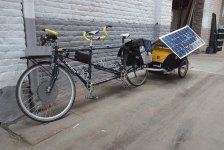
matmaxgeds
100 mW
- Joined
- Aug 14, 2016
- Messages
- 42
I also just saw this company who make solar canopies, maybe they have some economies of scale: http://motosola.com/
solarEbike
100 W
bakaneko said:Damn, I just checked solar panel prices on eBay and they are real low compared to when I built my 100W solar ebike like a couple years ago.
I didn't check the latest prices on eBay until I saw your post. Searching for "flexible solar panel" returns a lot of generic solar panels with non-Sunpower cells for under US $1/watt. Searching for "flexible sunpower panel" returns results priced at US $1.50-2.50/watt.
While any of these might be fine for casual prototyping on a limited budget, keep in mind some of the risks and hidden costs of buying from the lowest bidder on eBay. The anonymous, ephemeral nature of the sellers' and manufacturers' identities creates an incentive to exaggerate panel weight and output. The difficulty of measuring true panel output under the right temperature and irradiance conditions means that most buyers never realize they've been deceived. The cost of return shipping on a solar panel complicates returns and refunds.
I once bought a "200 watt" panel that turned out to be 110 watts at best and weighed significantly more than advertised. Given that I paid US $400 (minus $80 partial refund) and couldn't use the panel it was by far the most expensive one I've ever bought in terms of $/Wh.
Panel longevity is another consideration and this one is even more difficult to evaluate as a buyer. A solar panel mounted on an ebike is subject to extreme conditions: shocks, vibrations, moisture and thermal cycling are all trying to destroy your panel. The best solution uses high quality materials and observes rigorous testing and quality assurance. Consider the pressure that is put on a manufacturer to cut corners when they're competing for the lowest price on the market.
If you're serious about optimizing your solar watt-hours per kilogram then you'll want to use a solar panel made with Sunpower's highest grade back-contact Maxeon cells (PDF) which produce 3.4-3.7 watts per 125x125mm cell. Sunpower sells the bare cells to panel manufacturers at around US $2/watt. Any solar panel claiming to use Sunpower cells which sells for less than US $3/watt is likely made from defective, mismatched reject cells which Sunpower dumps on the Chinese market. Frankly, I'm kind of amazed that Sunpower continues this practice as it dilutes the value of their brand name.
So, try to buy from a seller who has been around for a while and stands by their products. Somewhere between the bottom of the barrel and the ultra-premium race-grade custom-made stuff there's a sweet spot for every project. You'll have to use your best judgement to find yours.
wturber
1 MW
solarEbike said:While any of these might be fine for casual prototyping on a limited budget, keep in mind some of the risks and hidden costs of buying from the lowest bidder on eBay. The anonymous, ephemeral nature of the sellers' and manufacturers' identities creates an incentive to exaggerate panel weight and output.
<sarcasm> OTOH, ebay seems to be the place where you can find the most high tech of 18650 cells. One need not look far to find 18650 cells that have 6800, 7900, and even 9900mah capacities. So clearly ebay must offer the leading edge of high tech componentry</sarcasm>
I buy plenty from ebay. And there can be excellent values. But you really do need to shop carefully and hopefully rely on feedback about sellers and what they sell from reliable third parties.
I mean the solar panels I got from eBay met the output specifications under ideal conditions - solar noon, no clouds, summer, optimal tilt. The rest of the time it was at like average a bit above 50%. Not sure how the "premium" ones compare under the same conditions. I mean if you are going to pay double just for 60% versus 50% its not worth it to me. I had 100W on mine so on average I was pulling about 50W obviously buffered by a Li-ion battery. I hope to make a solar recumbent or trike with great aerodynamics and a 200W flexible panel (possible 600W 3x200 with two extended awnings at rest) but also have it be safe. I do not like the full reclined recumbent trikes; it just seems too low and too dangerous to me.
A pyranometer is invaluable for such testing - and they are relatively cheap ($140 or so.)bakaneko said:I mean the solar panels I got from eBay met the output specifications under ideal conditions - solar noon, no clouds, summer, optimal tilt. The rest of the time it was at like average a bit above 50%. Not sure how the "premium" ones compare under the same conditions.
thundercamel
10 kW
Keep an eye on Craigslist, LetGo, ect. for used recumbents. Most don't have suspension, but I was able to get this Optima Lynx for $280. Swapped out the wheels and got a front suspension fork to work!bakaneko said:Too bad recumbent bikes are still a billion dollars. LOL
thundercamel said:Keep an eye on Craigslist, LetGo, ect. for used recumbents. Most don't have suspension, but I was able to get this Optima Lynx for $280. Swapped out the wheels and got a front suspension fork to work!bakaneko said:Too bad recumbent bikes are still a billion dollars. LOL
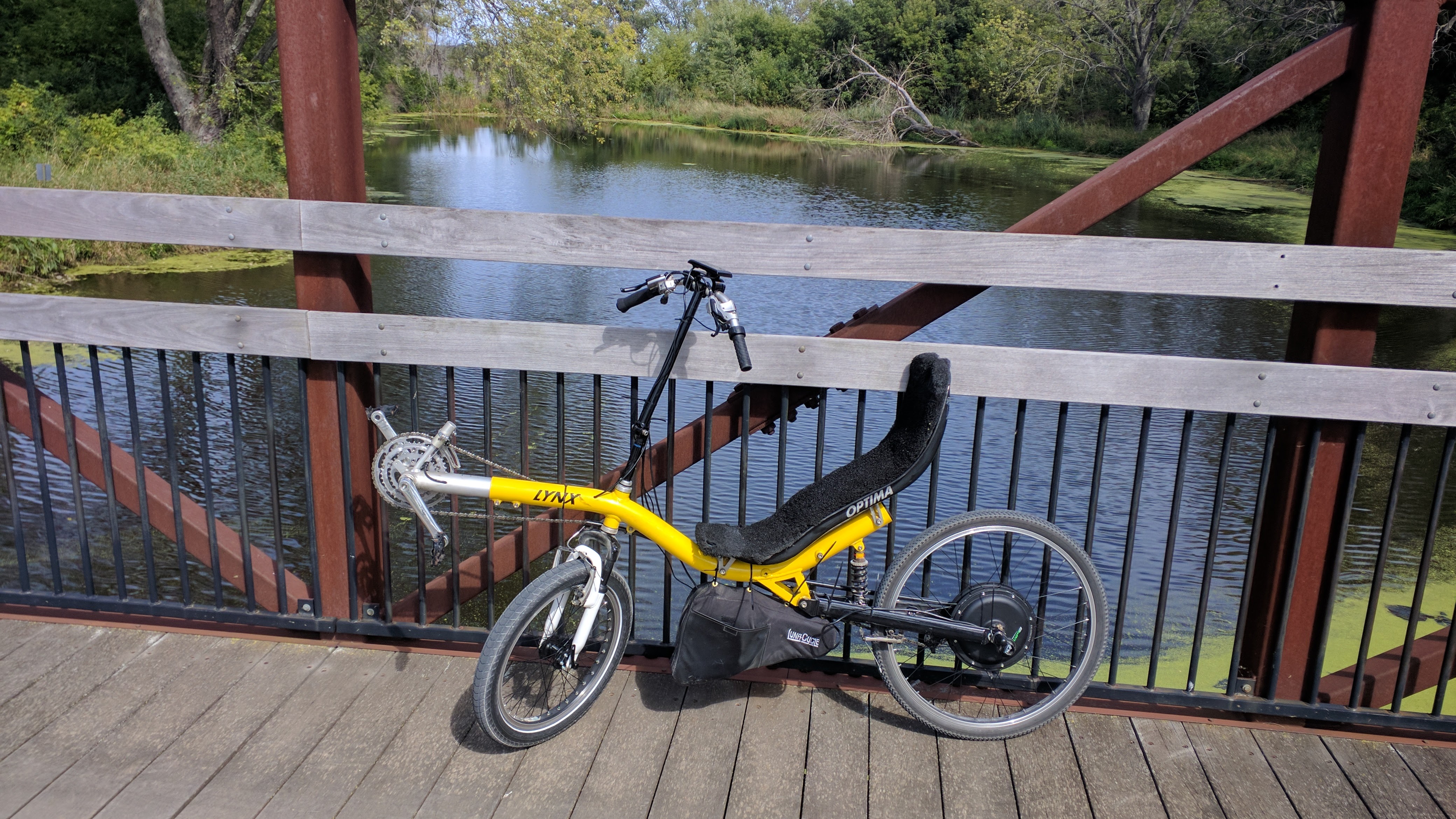
Very nice find.
solarEbike
100 W
wturber said:<sarcasm> OTOH, ebay seems to be the place where you can find the most high tech of 18650 cells. One need not look far to find 18650 cells that have 6800, 7900, and even 9900mah capacities. So clearly ebay must offer the leading edge of high tech componentry</sarcasm>
I buy plenty from ebay. And there can be excellent values. But you really do need to shop carefully and hopefully rely on feedback about sellers and what they sell from reliable third parties.
I think that's a good analogy. Solar panels and 18650 cells are both basic building blocks for projects like this and eBay (and Amazon, AliExpress, Banggood, Taobao and their ilk) are efficient mechanisms for exploiting buyer ignorance. This forum has a wealth of information about good and bad 18650 cells and vendors. I'm hoping to contribute to something similar for lightweight solar panels. I also buy all the time from eBay but it's mostly stuff like plastic or aluminum stock that I can't get anywhere else in small quantities or specialized drill bits I may only use once.
bakaneko said:I mean the solar panels I got from eBay met the output specifications under ideal conditions - solar noon, no clouds, summer, optimal tilt. The rest of the time it was at like average a bit above 50%. Not sure how the "premium" ones compare under the same conditions. I mean if you are going to pay double just for 60% versus 50% its not worth it to me.
I suspect you're not alone in wondering why anyone would be willing to pay more than the absolute minimum for a 100 watt solar panel. It has nothing to do with getting 60% vs 50% when it's cloudy. If you bought the cheapest panel on eBay and it meets your expectations then congratulations, you've made the right decision.
I've bought 10 lightweight solar panels over the years, starting at around $2/watt all the way up to the $10-20/watt range. The most expensive one has almost the same output as the best of the cheap bunch under the same solar conditions. So... either I'm a complete moron or I'm placing a high value on some performance metric you haven't considered.
There's definitely a law of diminishing returns here. Your budget and priorities will determine which panel is right for you. I started with the cheapest recumbent I could find (see below) and installed the cheapest motor kit, complete with 24V lead batteries. It was enough to get me hooked. I've been upgrading with each successive build.
To help clear things up, I propose sorting lightweight solar panels into four categories:
Entry level
- US $0.50-2/watt
- Advertised specs: 100 watts, 1.7 kg, 0.57 square meters
- Actual specs: 55-90 watts, 1.9 kg, 0.57 square meters
- Every detail optimized to reduce cost: low grade mismatched cells, lowest cost lamination materials, shipped in inadequate packaging. Based on my handful of purchases, you have a 50/50 chance of getting something that's close to the advertised specs and arrives undamaged. Suitable for casual beginners and anyone who likes Russian roulette.
- Anonymous manufacturer, pseudo-anonymous vendor make it easy to hide from poor reviews by setting up shop under a different name overnight. I took a screenshot of a current listing on eBay for a 100W panel for US $51, including shipping from China. WTF?
Mid range
- US $3-7/watt
- Advertised specs: 104 watts, 1.4 kg, 0.61 square meters
- Actual specs: 104 watts, 1.4 kg, 0.61 square meters (26% lighter than entry level)
- Genuine Sunpower cells bought directly from Sunpower. Higher quality lamination materials. Custom sizes made to order. You're dealing directly with the manufacturer. The specs match what's in the box.
- Manufacturers with established names have an incentive to protect their reputation. I can vouch for Solbian from personal experience. LinkSolar may be a lower-cost Chinese option but I don't have enough information to recommend them.
Race grade
- US $10-20/watt
- Advertised specs: 103 watts, 0.38 kg, 0.49 square meters
- Actual specs: 103 watts, 0.38 kg, 0.49 square meters (80% lighter, 16% smaller than entry level)
- You're paying a significant premium for a significant weight reduction. You're getting Sunpower's highest grade cells. Panel size, cell configuration, lamination materials are all customized to your design goals. Reduced panel weight and size enables reduction in mounting hardware. Expect long lead times.
- See SunCat Solar, Gochermann Solar, Mito Solar.
Satellite grade: If you have to ask, you can't afford it. Move along. Nothing to see here.
billvon said:A pyranometer is invaluable for such testing - and they are relatively cheap ($140 or so.)
Agreed. I have one of these Daystar irradiance meters. I picked it up nine years ago for $150. There's one currently listed on eBay for $100. It's basically a calibrated reference PV cell and a display that shows watts per square meter. Add a thermocouple or infrared thermometer to measure cell temperature and you take the guesswork out of measuring solar panel output.
thundercamel said:Keep an eye on Craigslist, LetGo, ect. for used recumbents. Most don't have suspension, but I was able to get this Optima Lynx for $280. Swapped out the wheels and got a front suspension fork to work!
That looks like a sweet build. Nicely done.
Bonus round for reading all the way to the end! Looking for a fixer-upper tadpole trike? Live in the SF Bay Area? I'm putting the bike pictured in this photo up for adoption MINUS the solar panel, panier, motor, mudguards, flag and fairing. "Recumbent USA" brand, made in Taiwan, no suspension, needs work, free to a good home. Send me a DM.
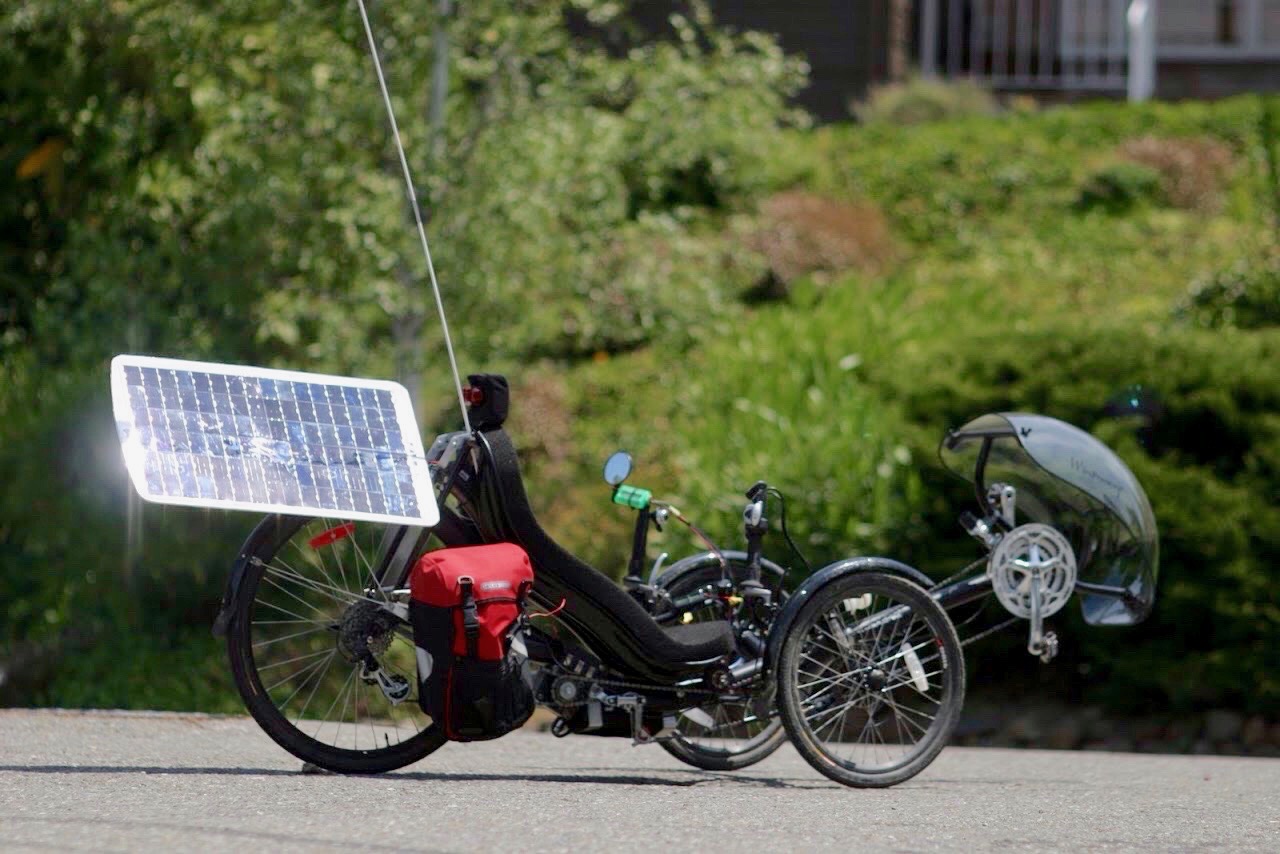
I don't just randomly buy cheap solar panels from eBay hoping for the best. I look for domestic importers/manufacturers that use eBay as another store front and have a review history online. Mine was at about $1 per watt. The 50-100% performance is due to solar conditions. In optimal conditions, they always performed close enough to 100%.
Its been a while but I know there is technologies that increase performance at non optimal tilts, which would be worth considering paying more. I mean I haven't seen any solar panel that perform at 100% without the optimal tilt and conditions. The customization is definitely worth a premium too. The 150-200W panel is going to be a beast and integrating it cosmetically with a custom layout is also worth considering.
Unfortunately, I think trikes and recumbent bikes are the only feasible solar option for ebikes. I've tried the trailer/extension and its just too hideous and en-cumbersome. This is good work that you are doing; its just that I've always done things with a budget conscious mind and though not the norm it is not rare to have both a good bike/setup within a cheap budget just obviously not the best.
The question is on these trikes/recumbent bikes is if a 150-200W solar panel will fit cosmetically. I just don't think 100W will cut it for the USA power hungry ebikers.
Its been a while but I know there is technologies that increase performance at non optimal tilts, which would be worth considering paying more. I mean I haven't seen any solar panel that perform at 100% without the optimal tilt and conditions. The customization is definitely worth a premium too. The 150-200W panel is going to be a beast and integrating it cosmetically with a custom layout is also worth considering.
Unfortunately, I think trikes and recumbent bikes are the only feasible solar option for ebikes. I've tried the trailer/extension and its just too hideous and en-cumbersome. This is good work that you are doing; its just that I've always done things with a budget conscious mind and though not the norm it is not rare to have both a good bike/setup within a cheap budget just obviously not the best.
The question is on these trikes/recumbent bikes is if a 150-200W solar panel will fit cosmetically. I just don't think 100W will cut it for the USA power hungry ebikers.
solarEbike
100 W
bakaneko said:I don't just randomly buy cheap solar panels from eBay hoping for the best. I look for domestic importers/manufacturers that use eBay as another store front and have a review history online. Mine was at about $1 per watt.
I also did my research and still ended up with some good panels and a couple of duds. My comments were not intended to be a personal attack. At $1/watt there's an element of luck involved.
bakaneko said:Its been a while but I know there is technologies that increase performance at non optimal tilts, which would be worth considering paying more.
I know the technologies of which you speak: anti-reflective surface treatments, better temperature coefficients of power, higher efficiencies at low irradiance levels ("shade tolerant"), etc. Solar panel manufacturers love to point these out in their marketing materials but the gains are very small. The PVWatts calculator allows you to specify "Standard", "Premium" or "Thin film" but the difference in annual Wh is on the order of 2-3%.
bakaneko said:I mean I haven't seen any solar panel that perform at 100% without the optimal tilt and conditions.
That would be nice but the physics kind of gets in the way. If your 100 watt panel isn't receiving 1000 w/m^2 and the cell temperature isn't 25°C then it's not going to output 100 watts. It cannot convert energy if it's not receiving energy.
To get 25°C cell temperature, you need about 0°C (32°F) ambient air temperature, give or take a bit for air flow. On a hot summer day in Texas, cell temperatures can reach as high as 75°C. Assuming you have Sunpower Gen III cells with a temperature coefficient of power of -0.29%/ºC that means you're down to 85.5 watts. With a generic monocrystaline front-contact solar panel, the coefficient may be as high as -0.47%/°C so you'd be down to 76.5 watts even with optimal tilt.
As for tilt angle, most of your energy comes from Direct Normal Irradiance (DNI) with a small contribution from Diffuse Horizontal Irradiance (DHI). Assuming you're getting 1000 w/m^2 at solar noon with the sun's rays perpendicular to your panel, if your panel tilt is off by 10° then you're getting 1.5% less DNI. Off by 20° the loss is 6%, off by 40° the loss is 23%. In reality it's a bit more complicated because at higher incidence angles the reflection losses go way up and diffuse irradiance is less impacted by non-optimal tilt angles but it's a decent first order approximation.
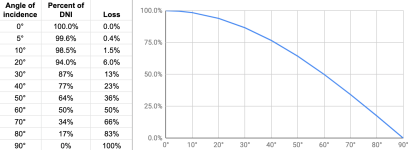
bakaneko said:The 150-200W panel is going to be a beast..
Thanks for pointing that out. If you're only adding 50-100 watts, the added weight is hardly noticeable. Above that, it really starts to add up. With a big, heavy battery pack you can position it low and centered but a solar panel will always be far from the center of mass and the impact on bike handling is an important consideration. This was a big part of how I ended so obsessed with weight reduction.
Cephalotus
10 kW
- Joined
- Jun 18, 2012
- Messages
- 755
This is what I got from China.
It is far from being the cheapest stuff (ETFE lamination at ca. 3€/W) and it still is able to produce the 50W it has been advertised.
So if you notice that your cheap semi flexible panels already produce less power than advertised their cells will look even worse than in that module...
If you want to use them for a long trip go ahead, I woudn't.
IR Pictures can be made easy and cheap with a dark room, a suitable DC power source to reverse power the solar module (bypass any diodes) and an old Sony F717 or Sony F828 with s small magnet to put it into "nightshot" mode.
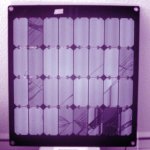
It is far from being the cheapest stuff (ETFE lamination at ca. 3€/W) and it still is able to produce the 50W it has been advertised.
So if you notice that your cheap semi flexible panels already produce less power than advertised their cells will look even worse than in that module...
If you want to use them for a long trip go ahead, I woudn't.
IR Pictures can be made easy and cheap with a dark room, a suitable DC power source to reverse power the solar module (bypass any diodes) and an old Sony F717 or Sony F828 with s small magnet to put it into "nightshot" mode.

solarEbike
100 W
Cephalotus said:IR Pictures can be made easy and cheap with a dark room, a suitable DC power source to reverse power the solar module (bypass any diodes) and an old Sony F717 or Sony F828 with s small magnet to put it into "nightshot" mode.
This is great. Thanks for sharing. I remember we talked about this a while back.
This is electroluminescence, right? Driving current trough the panel in reverse causes each cell to emit infrared light which is picked up by the Sony camera. The magnet is a trick for disabling the IR filter in the camera. The cracks in your image are micro-cracks which are otherwise invisible to the naked eye under normal lighting conditions?
So, you all might be wondering what is the significance of these cracks if the panel still puts out 50W? Per their own datasheet, "When a SunPower cell does crack, the backside copper metal foundation keeps the cell intact and maintains a high power output." Solbian published the results of some in-house tests where they severely abused two panels made with Sunpower cells and one with polycrystalline cells and left them outside soaking in water for a year. They reported 9-13% power loss for the Sunpower panels and 45% loss for the poly panel.
Areas with cracks create hotspots which soften the plastic encapsulation materials around them, making them more vulnerable to additional damage in that area. This is especially true for solar panels on a bicycle where the panel is only supported by widely spaced ribs and the whole assembly is always bouncing around like a trampoline. The cracks are more likely to get worse over time resulting in more power loss. The effect is slow and gradual and may be hard to detect.
Cephalotus said:...a suitable DC power source to reverse power the solar module...
How do you figure out what is suitable for a given solar module without damaging it? I'm getting curious to try this out.
Cephalotus
10 kW
- Joined
- Jun 18, 2012
- Messages
- 755
solarEbike said:This is electroluminescence, right? Driving current trough the panel in reverse causes each cell to emit infrared light which is picked up by the Sony camera. The magnet is a trick for disabling the IR filter in the camera. The cracks in your image are micro-cracks which are otherwise invisible to the naked eye under normal lighting conditions?
Yes on everything.
So, you all might be wondering what is the significance of these cracks if the panel still puts out 50W? Per their own datasheet, "When a SunPower cell does crack, the backside copper metal foundation keeps the cell intact and maintains a high power output."
First the effect is low. Maybe 2-3% in my panal which I'm simply not able to measure reliable not having a calibrated flasher. Most people measure open circuit voltage and short circuit current. Even if your panel is very bad you most likely wouldN#t be able to notice a performance drop in both parameters, even if P MPP is affected by more than 50%
from the suntrip files posted at ebikes.ca I took a look at power output of some riders vehicle.
Calculating the theoretical solar irradiance I get:
Lyon (46° N / 5°E) at June 30th and 12:45 MEZ: AM = 1,08; P Solar = 952W/m² on flat surface and 1033W/m² for 22° tilted to south
Guangzhu (24° N / 113°E) at August 30th and 5:30 Uhr: AM = 1,00 P Solar = 1054W/m² on flat surface and 1054W/m² for 1° tilted to south
So maximum power should be similar or even higher at end of August in Guangzhu compared to end of June in Lyon.
Here is maximum output of Jack Butlers solar array:
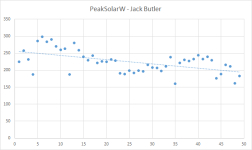
And here for comparison Mickael Joguet:
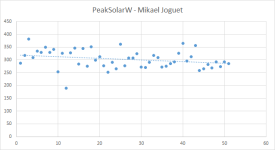
I don't know, but I assume that the solar panels Jack Butler used did have significant performance problems at the end.
When searching for a picture of the mounting of his solar panels I noticed that he crashed his bike.
No wonder the performance hit in that case, it's even amazing that the performance hit hasn't been worse:
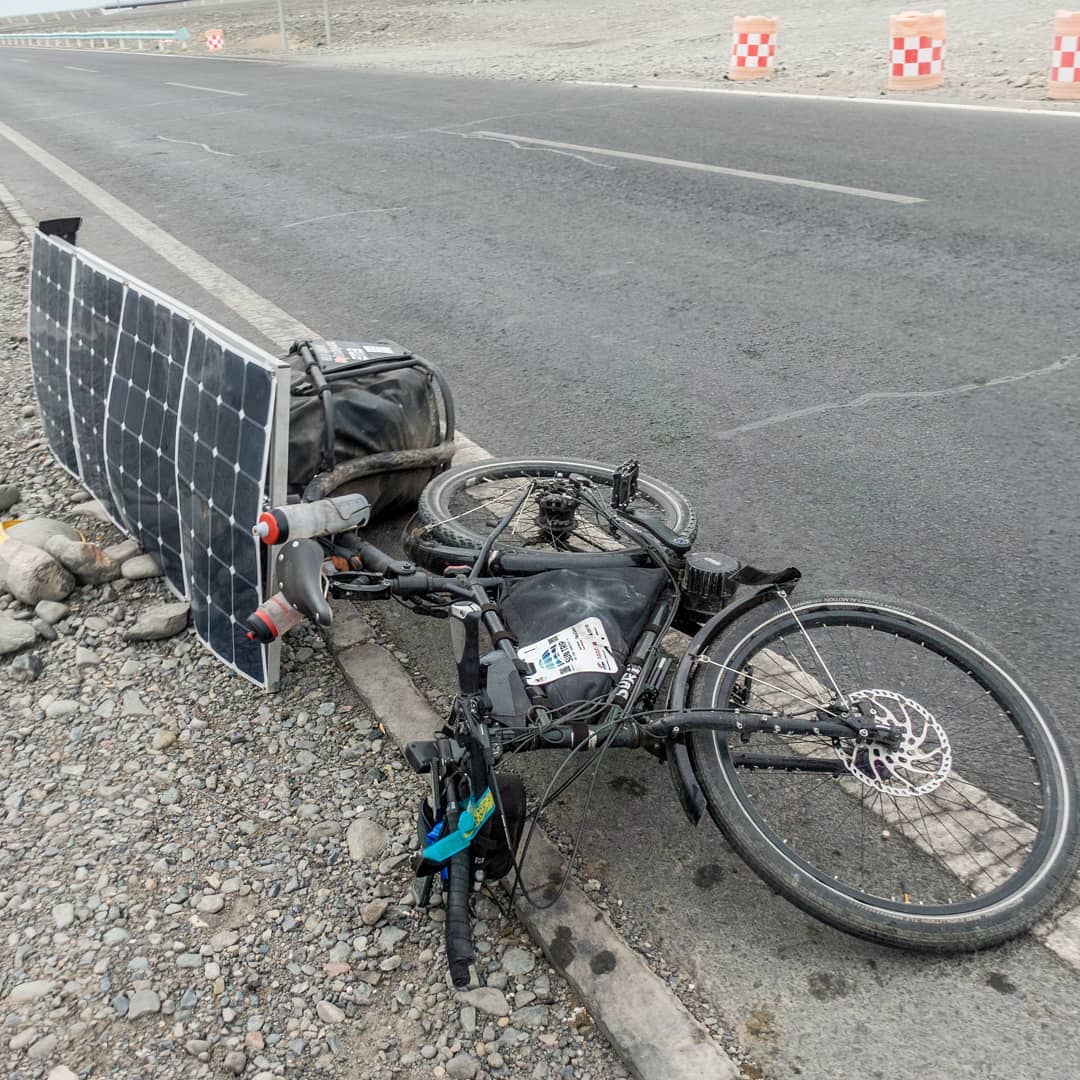
Areas with cracks create hotspots which soften the plastic encapsulation materials around them, making them more vulnerable to additional damage in that area.
This is exactly what happens. Hot spots are worse for the cheap modules encapsulated in PET. ETFE withstands higher temperatures.
If you shortcut your moduls hotspots in bad cells are amplified. This happens with some of my modules:
usually you do not short cut your moduls, so problems are not so bad as shown on the right side but you can notice the bad cells in MPP , too...
To cool the bad cells is one reason why I want to use a aluminium back side, even if that adds 2,2kg /m² to the modules.
Cephalotus said:...a suitable DC power source to reverse power the solar module...
How do you figure out what is suitable for a given solar module without damaging it? I'm getting curious to try this out.
usually you should use a current around the short circuit current of the moduls, but for sun power cells half of that works fine, too, they are quite efficent IR emitters. Voltage must be higher than open circuit voltage of course.
solarEbike
100 W
Cephalotus said:Here is maximum output of Jack Butlers solar array... I don't know, but I assume that the solar panels Jack Butler used did have significant performance problems at the end. When searching for a picture of the mounting of his solar panels I noticed that he crashed his bike.
Interesting idea to look at the daily peak solar watts. I remember Jack's crash. It happened in the Gobi Desert. He posted that photo on IG on July 27 so this would have been somewhere around day 40? I’m not sure the data shows a clear power drop after the event.
I got curious so I checked the linear trend line for daily peak solar watts for the other participants, excluding zero travel days as they tended to be outliers. They all show a similar downward trend. Expressed as a % loss per day, they look like this:
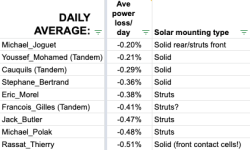
There appears to be a correlation between power loss and panel mounting strategy. Panels mounted to a solid surface fared better than panels mounted on ribs/struts (where they're subject to more stress and possible cell cracking) from road vibrations. The one exception to this trend is Thierry Rassat's bike (video) which is using traditional monocrystaline front-contact cells instead of metalized back-contact Sunpower cells so it would be much more vulnerable to any cell cracks. Tierry's peak output appears to have dropped by 50% over 100 days.

Overall, the decreases in peak daily solar watts seem too high to me to be explained by panel degradation alone. I remember Justin commenting on the fact that it was very rainy during the second half of the trip. If it was overcast all day, the daily peak would be much lower. Maybe that's part of it?
I posted the shared spreadsheet with all the imported daily data here. Anyone can download it in Excel or OpenDocument format using File > Download. If you log in with a Google account, you can use File > Make a copy to save your own copy which can then be edited in the browser: https://docs.google.com/spreadsheets/d/1W9OyghiQpFIGjzOiGsGe0LiDR2yYv79qxzgNIZ2uDFs/edit?usp=sharing
Cephalotus
10 kW
- Joined
- Jun 18, 2012
- Messages
- 755
solarEbike said:Overall, the decreases in peak daily solar watts seem too high to me to be explained by panel degradation alone. I remember Justin commenting on the fact that it was very rainy during the second half of the trip. If it was overcast all day, the daily peak would be much lower. Maybe that's part of it?
Best way to analyse this now would be to make IR photographs of the used modules.
For peak power you need full sun, obviously. But actally partly cloudy days provide the maximum peak solar power, when sun is reflected on white clouds (this can increase power up to 20% compared to full clear sky) and modules are still cold from the last cloud.
My assumption would be that air pollution in China does have an impact. East Germany where I live had an increase of average and peak solar irradiation by ca. 5% since fall of the Eastern block and shutting down the dirties power plants there and in neighboring Poland and Check republic.
I doubt that there was no sun for Thierry after day 20, when his solar paneles output crossed 300Wp for th last time, until day 99.
For Mickael Joguet the peak output at day 40 and day 43 near the end was as high as at the beginning. The very small difference could be anything like heat of the solar generator or air pollution.
I posted the shared spreadsheet with all the imported daily data here. Anyone can download it in Excel or OpenDocument format using File > Download. If you log in with a Google account, you can use File > Make a copy to save your own copy which can then be edited in the browser: https://docs.google.com/spreadsheets/d/1W9OyghiQpFIGjzOiGsGe0LiDR2yYv79qxzgNIZ2uDFs/edit?usp=sharing
Highly appreciated.Thanks.
Did you find out the highest daily Wh/Wp for all riders so someone could guess what would be possible under good to ideal solar conditions.
I could do it myself if I would be able to find out the installed solar power for each rider.
solarEbike
100 W
Cephalotus said:Best way to analyse this now would be to make IR photographs of the used modules.
Or fully calibrated power measurements with irradiance and cell temperature, taken before and after the race but that's not likely to happen either. It would also eliminate errors in reported panel output ratings. Raf and Bernard reported bare cell numbers without accounting for encapsulation losses and most of the others relied on vendors' claimed specs.
Cephalotus said:For peak power you need full sun, obviously. But actally partly cloudy days provide the maximum peak solar power, when sun is reflected on white clouds (this can increase power up to 20% compared to full clear sky) and modules are still cold from the last cloud.
I usually get my highest output during the first few seconds after I take my bike out of my cool garage and roll it out into the sunlight. I considered trying to compensate for transient effects like edge of cloud or even reflected light by taking the 10th or 100th highest solar watts for each day instead of the highest value which may have only lasted for 1 second but I'm too lazy to write a script to extract that data.
Cephalotus said:Did you find out the highest daily Wh/Wp for all riders so someone could guess what would be possible under good to ideal solar conditions. I could do it myself if I would be able to find out the installed solar power for each rider.
Yes. It's here:
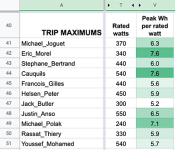
Similar threads
- Replies
- 122
- Views
- 24,020
- Replies
- 22
- Views
- 13,837

